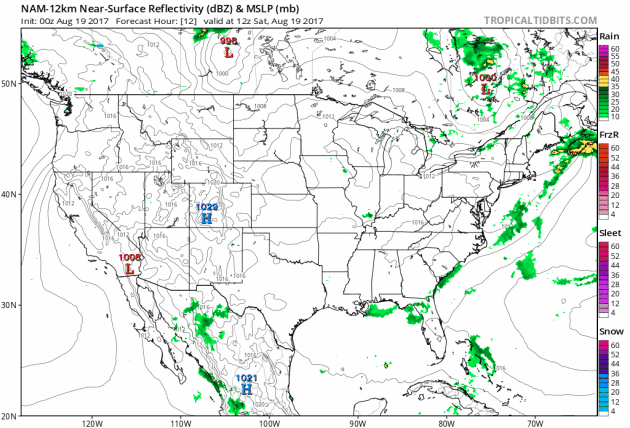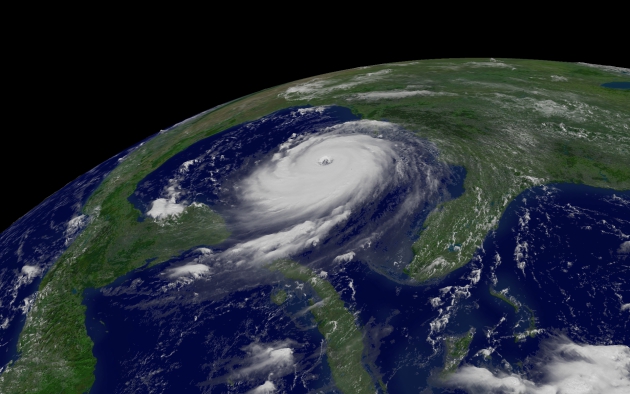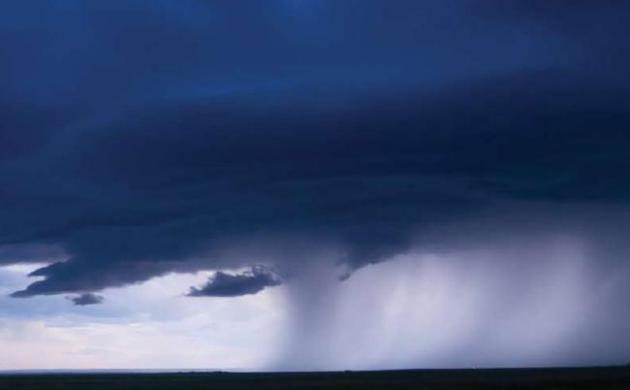75 F. high on Friday in the Twin Cities.
80 F. average high on August 18.
85 F. maximum temperature on August 18, 2016.
August 19, 1980: Strong winds at Belle Plaine severely damage five planes.
Wednesday Rain Event Was the Biggest Since 2012
When in doubt, which is much of the time, predict rain. Odds are you'll be right. It's raining harder and longer than it did for your grandparents. The Minnesota Climate Office counts 4 separate 1-in-1,000 year flood events in Minnesota since 2000. I'm no statistician, but that one leaves me scratching my head.
Wednesday's statewide soaker may have been the biggest rain event since the Duluth flood of June, 2012. Over 8" at Redwood Falls; the MN DNR estimates 60 percent of the state picked up 1-2" of rain. Unusual for any month - especially odd for August, when precipitation is convective or showery.
Expect enough sunshine for 80F today; mid-80s on Sunday with an isolated thunderhead sprouting. Sadly, U.S. and European models still bring a smudge of showers & T-storms into Minnesota Monday.
The odds of actually seeing the eclipse (here) are roughly 1 in 3. Skies will darken at midday as the moon passes in front of the sun. Even if it's visible resist the urge to stare at the sun.
Expect a sunny, comfortable start to the fair, but more rain arrives next weekend. My apologies.
* Map above shows predicted percentage of the sky that will be covered in clouds at 1 PM CDT Monday, close to peak eclipse time for much of the central USA. Twin Cities? 66% cloud covered.
Biggest Rain Event for Minnesota Since Duluth Flood of 2012. The Minnesota DNR has timely perspective on Wednesday's flooding rains and tornadoes: "...This was the most widespread and intense rainfall event of the year (to date) in Minnesota, with 1-2 inch totals covering approximately 50,000 square miles, or about 60% of the state. Totals of greater than three inches were concentrated in a multi-county area in western and central Minnesota, generally centered on the Minnesota River. The largest official rainfall report came from Redwood Falls, where a volunteer with the National Weather Service's cooperative observer program reported 8.12 inches in 24 hours. Two "unofficial" automated gauges in the area actually reported more rain, but the 8.12 inches recorded at Redwood Falls is the largest official 24-hour precipitation total in Minnesota since June 20th, 2012, when Two Harbors reported 10.45 inches during the worst flood in that area's recorded history. Fortunately, the tornadoes were short-lived and relatively weak. Of the seven confirmed by the National Weather Service in Chanhassen, six were rated at EF-0. The lone EF-1 tornado damaged a farmstead near the Nicollet-Sibley county border, in the township of New Sweden..."
8th Tornado on Wednesday. Late Friday the local National Weather Service sent out information about an 8th tornado in the Prior Lake area, an EF-0 strength twister that caused minor damage.

Velocity Signature. Here is the radial velocity couplet that showed up on the (RadarScope) weather app Wednesday evening near Prior Lake. A Tornado Warning was issued for this rotating cell.
What a Rainy Week! Dr. Mark Seeley is master of the understatement in this week's edition of Minnesota WeatherTalk: "Over the past week many parts of the state have reported rainfalls totaling over 5 inches. Thunderstorms over August 13-14 brought record-setting rainfall to some Minnesota communities, including: 3.75 inches at Montevideo; 3.00 inches at Alexandria; 2.20 inches at Windom; 2.04 inches at Long Prairie; and 1.38 inches at Grand Portage. Then even heavier rains came over August 16-17 this week, along with a few tornadoes in Nicollet, Sibley, and Blue Earth Counties, all very short-lived. The rainfall in these thunderstorms was record-setting at many locations, even more so than the rains earlier in the week. Some of the new record amounts were: 8.12 inches at Redwood Falls (many flooded basements); 4.11 inches at Willmar; 3.98 inches at Vesta; 3.66 inches at Marshall; 3.57 inches at Montevideo; 3.18 inches at Melrose; 2.88 inches at Pokegama Dam; 2.73 inches at Lake City; 2.67 inches at Pipestone..."

Photo credit: "About 11 million people in India have been hit by flooding."
Past Weather in the Twin Cities for the August 21, 2017 Eclipse. Here's a clip from the Minnesota DNR and State Climatology Office: "...And what should we expect from the August 21st, 2017 eclipse? We should see a noticeable loss of daylight, even if it's cloudy, because up to 86% of the available sunlight will be blocked by the moon. Partial eclipses of the past have produced dusk-like sunlight levels, even during the middle of the day. The 2017 eclipse will occur at a time when temperatures normally would be climbing by a degree or two per hour, but we should expect temperatures to lose ground for an hour or so, possibly affecting our ability to reach what would have been the high temperature otherwise. Although we will not be in the "path of totality," observant Minnesotans will have no problem recognizing the partial eclipse..."
A New Tornado Alley is Forming in America's Southeast. Meteorologists are noticing the trends, highlighted by Bloomberg: "...In terms of the number of twisters, Tornado Alley is still dominant. But in recent decades, the bulk of the destruction inflicted by these storms has shifted to the southeast U.S., a swath of states from Louisiana to Georgia meteorologists have dubbed Dixie Alley. Since 1997, on average, tornadoes in Dixie Alley have caused more than $600 million in property damage annually (accounting for inflation) and killed more than 40 people a year, compared with $470 million in damage and 13 deaths a year in Tornado Alley. And that’s despite almost 3,000 more twisters touching down in Tornado Alley during that time...Weather conditions aren’t the only factor when considering the destruction in Dixie Alley. A higher proportion of people there live in mobile homes than do people in Tornado Alley. These structures are particularly vulnerable during a storm and contribute to the increasing share of fatalities in Dixie Alley. The Southeast is also more populated than the Great Plains states in Tornado Alley. Georgia is among the fastest-growing states in the U.S., with many transplants settling in and around Atlanta, which has grown 41 percent since 2000. The Birmingham, Alabama, metro area has grown 25 percent, and Nashville, Tennessee, is up 52 percent during that time, too..."
7 Confirmed Tornadoes Wednesday Evening.
After on-site surveys the Twin Cities office of the National Weather
Service confirmed a total of 7 separate tornadoes Wednesday. 6 of these
were EF-0 strength, with winds under 85 mph. The tornado that touched
down near New Sweden was estimated to be an EF-1, with winds closer to
105 mph. More details here.
"Flash Drought" Threatens Crops and Cattle. Just like a flash flood, flash droughts can come on suddenly, often with little warning. Here's an excerpt from High Country News: "...The
current catastrophe began as a “flash drought,” a dry period that comes
on very quickly. Late spring and early summer are typically pretty
soggy in the northern Great Plains — but not this year, says Natalie
Umphlett, regional climatologist and interim director of the High Plains
Regional Climate Center at the University of Nebraska. If the region
doesn’t get enough rain during that critical time, she says, “it’s hard
to make that up...”
July: Second Warmest Month on Record, Worldwide. NOAA's records have last month as second-hottest, just behind July, 2016. Here are details: "The
average global temperature in July was 1.49 degrees F above the
20th-century average of 60.4 degrees, according to scientists from
NOAA’s National Centers for Environmental Information. This was the
second-highest average temperature for July in the 138-year climate
record, trailing last year. July 2017 marked the 41st consecutive July
and the 391th consecutive month with temperatures at least nominally
above the 20th-century average.
Year to date | January through July 2017
The
year-to-date average temperature was 1.62 degrees F above the
20th-century average of 56.9 degrees. This was the second-warmest for
this period, a quarter of a degree behind the record set in 2016..."

- Seventy-four percent of the deaths related to Hurricane Katrina were among those age 60 and older, and 50 percent of these were among people over age 75, according to a 2006 study.
- In the year after Hurricane Katrina, displaced students in Louisiana public schools, on average, performed worse in all subjects and grades compared with other students. In addition, displaced students experienced a variety of problems related to attendance, academic performance, behavior and mental health, according to a 2010 report..."
Normandy's D-Day Beaches Invaded by Green Algae. Details via Reuters: "Normandy's
D-Day beaches, where Allied troops landed in June 1944 to free Europe
of Nazi occupation, are being invaded by green algae. Beaches such as
Omaha and Juno, visited by millions of tourists each year, struggle with
the algae, which is not toxic, but the stench as it decomposes can be a
turnoff. "It's gross, the algae stinks as it rots and it attracts
flies," said Sylvie, who lives in Caen. Every day, resort towns use
tractors to shovel the algae to the far end of the beaches at low tide,
but winds push the green, red and brown seaweed back onto the beaches
where in some areas it piles up metre-deep against the boardwalks..."
We Saved the Ozone. Here's How We Can Save Everything Else. GOOD describes international efforts to ban harmful chemicals. The climate challenge is much more daunting, since it requires a reduction in the fossil fuels that still largely power the world: "...In the ’80s, climate scientists realized CFCs and HCFCs – heat-catching chemicals most commonly used as refrigerator coolants – were tearing holes in our planet’s atmosphere. The Montreal Protocol drew upon this evidence to enact laws that would have global repercussions, but it wasn’t until this latest study the rest of us learned about the benefits the United States has since incurred. Head researcher and study writer Lei Hu used the National Oceanic Atmospheric Administration’s atmospheric monitoring network to determine that eliminating these pollutants had the same effect as cutting carbon dioxide emissions by 170 million tons each year from 2008 to 2014. Hu and her team further estimated that maintaining the Montreal Protocol could help the U.S. cut an additional 500 million tons of CO2 by 2025 – that’s about a quarter of the emissions we need to cut in order to fulfill the Paris climate agreement, Gizmodo reports..."

Minnesota Releases Review on Disputed Enbridge Oil Pipeline. ABC News reports: "Minnesota
regulators on Thursday released the final environmental review of
Enbridge Energy's proposal to replace its aging Line 3 oil pipeline,
which carries Canadian tar sands crude across northern Minnesota to Wisconsin.
The state Commerce Department has updated and expanded the massive
document since it released the draft for public comment in May. Changes
include additional discussion of the socioeconomic impact of the
project, the potential impact on tribal resources and the potential
impact of oil spills, as well as the inclusion of public comments, the
department said. In the process, the main document grew to just over
2,000 pages, plus around 12,000 pages of appendices..."
Photo credit: "Hyundai Motors’ new hydrogen fuel cell vehicle is displayed during a media preview in Seoul, South Korea, Thursday, Aug. 17, 2017. Hyundai Motor says its new hydrogen fuel cell vehicle will travel more than 580 kilometers (360 miles) between fill-ups." (Lee Jin-man/Associated Press).

- America produced almost eight times as much electricity from sun and wind as we did in 2007, and those two sources combined to produce 10 percent of the nation’s total for the first time in March.
- At the same time, the country is using nearly 10 percent less energy per capita than a decade ago. Nearly all of that decline was in fossil fuels: In 2007, fossil fuel consumption (PDF) was 85.927 quads, compared to 2016 when it was 78.569.
- Breaking it down further, solar produced 43 times more power than 10 years ago, while wind produced seven times as much..."
Photo credit: "Glittering future." (Reuters/Carlos Barria)
Image credit: "The ‘bothie’ Dual Sight function on the new Nokia 8." Photograph: John Nguyen/Press Association.
Image credit: "Dubrovnik as King's Landing." HBO.
Photo credit: Cait Oppermann.
Photo credit: Bethan Mooney for TIME.
If you are lower in relationship power and have different brand preferences than your partner, you're probably going to find yourself stuck with your partner's favourite brands, over and over again.The researchers used brand preferences in soda, coffee, beer, chocolate, and cars to study individuals and couples over the course of two years. They found the results aligned with findings about relationship power and happiness, and although not seen as important conventionally, could weigh down a relationship. Brick said.."
This could lead to a death-by-a-thousand-cuts feeling.
Most couples won't break up over brand incompatibility, but it leads to the low power partner becoming less and less happy.
Image credit: Yannis Behrakis / Reuters.
On This Chilean Island, the Whole Community Helps Move Your Home. Atlas Obscura has a delightfully odd story: "Moving house can be a real
pain. But shuttling some boxes, a couch, and other detritus from point A
to point B is small potatoes compared to the ordeal of moving house for
the islanders of Chiloé, who physically move their homes from place to
place—sometimes over water. Floating off the coast of southern Chile,
the misty archipelago of Chiloé is a pastoral, sheep-dotted, and
drizzly, the austral equivalent to Ireland. Verdant forests fringe on
undulating fields that roll down to the sea, where palafito stilt houses
perch over tidal bays. The ocean provides a constant flow of fresh
catches, with the promise of sighting whales, dolphins, and penguins
(which are not on the menu). The snowy tips of volcanoes on the mainland
pierce the skyline..."
Photo credit: "Moving a house on Chiloe Island, known as a minga." Francisco Negroni/ Alamy.

TODAY: Partly sunny and mild. Winds: SW 5-10. High: near 80
SATURDAY NIGHT: Partly cloudy and mild. Low: 64
SUNDAY: Warm sun, isolated T-storm possible. Winds: SW 7-12. High: 85
MONDAY: Eclipse dud? More numerous T-storms. Winds: SE 5-10. Wake-up: 68. High: 79
TUESDAY: Damp start, then getting sunnier. Winds: NW 7-12. Wake-up: 64. High: 80
WEDNESDAY: Sunny with lower humidity levels. Winds: NW 5-10. Wake-up: 58. High: 76
THURSDAY: Comfortable sun for the State Fair. Winds: SE 5-10. Wake-up: 57. High: 77
FRIDAY: Partly sunny, stronger breeze kicks in. Winds: SE 10-15. Wake-up: 60. High: 78
Climate Stories...
.jpg)
Release Climate Report, and Follow the Science. Here's an excerpt of an Op-Ed from the Editorial Board at San Antonio's Express-News: "...Given the circumstances, then, it’s perfectly reasonable to be concerned about political manipulation or suppression. It’s also possible the report could quietly be released and then ignored. All of these outcomes would further undermine America’s global standing and harm future generations who will have to live with our failure to take these warnings seriously. These reports have value. The public and decision makers should read them and draw their own conclusions. By and large, the science points in a clear direction. The National Oceanic and Atmospheric Administration, for example, recently released its annual “State of the Climate” report, confirming that 2016 was the warmest year on record. That report doesn’t specifically link human activity to climate change, but it offers no shortage of troubling observations. Greenhouse gas levels were the highest ever recorded. Same with global surface temperatures and sea levels. Warming in the Arctic is outpacing the world. Precipitation cycles were more extreme..."

Photo credit: "Thousands of protestors gather in Denver Civic Center Park at the People’s Climate March on Denver on April 29, 2017 in Denver, Colorado." Credit: Marc Piscotty / Stringer.
Does Climate Change Cause Extreme Weather Events? A warmer climate correlates with hotter heat waves, more intense rainfall and deeper, more severe drought - but a causal connection with other forms of extreme weather isn't always possible. Here's an excerpt from Smithsonian.com: "...Thanks to advances in supercomputing and pooling hundreds of climate models developed by researchers across the world, they are also more statistically confident than ever in saying that intense storms, droughts and record-breaking heat waves are occurring with increased frequency because of humans. “Ten years ago we wouldn’t have been able to do so,” says Ken Kunkel, a climate scientist at North Carolina State University who also works with the National Oceanic and Atmospheric Administration. But teasing apart individual weather events is harder. The planet’s history is dotted with unexpected, prolonged heat waves and sudden damaging storms far before humans began pumping out greenhouse gases. “The big challenge is that these kind of extreme events have always happened,” says Kunkel, whose work focuses on heavy storms that cause considerable damage in the U.S. But, he says, “Can you say, ‘This event was caused by global warming? No...'"
File image: "A NASA image of Hurricane Sandy moving along the United States' East Coast. Extreme weather events like this are becoming more frequent, but scientists still face challenges when attributing any one storm to climate change." (NASA / Alamy)
Boston Startup Hopes Its Seeds Will Help Farmers Cope with Climate Change. WBUR-FM has an interesting story that focuses on agricultural resilience: "...Indigo's
goal is simple, albeit lofty: to help farmers sustainably feed the
planet. To do that, it's working to create drought-resistant seeds
coated with tiny microbes.
"Every plant in the world appears to have microbes living on the
insides of its tissues, and those microbes can be little bacteria, they
can be little fungi, they can be combinations of the two," explained
Geoff von Maltzahn, a co-founder of Indigo and a partner at Flagship.
These plant/microbe partnerships have taken place naturally over
millions of years of evolution, and so von Maltzahn wondered: If
certain plants were able to survive a drought better than others, maybe
that tolerance was coming from the plant's microbiome..."
Photo credit: "Indigo
Agriculture's goal is simple, albeit lofty: to help farmers sustainably
feed the planet. To do that, it's working on creating drought-resistant
seeds coated with tiny microbes. Here, Geoff von Maltzahn, the
co-founder of Indigo, checks on the plants in the company's grow room at
its Charlestown headquarters." (Jesse Costa/WBUR)
No comments:
Post a Comment